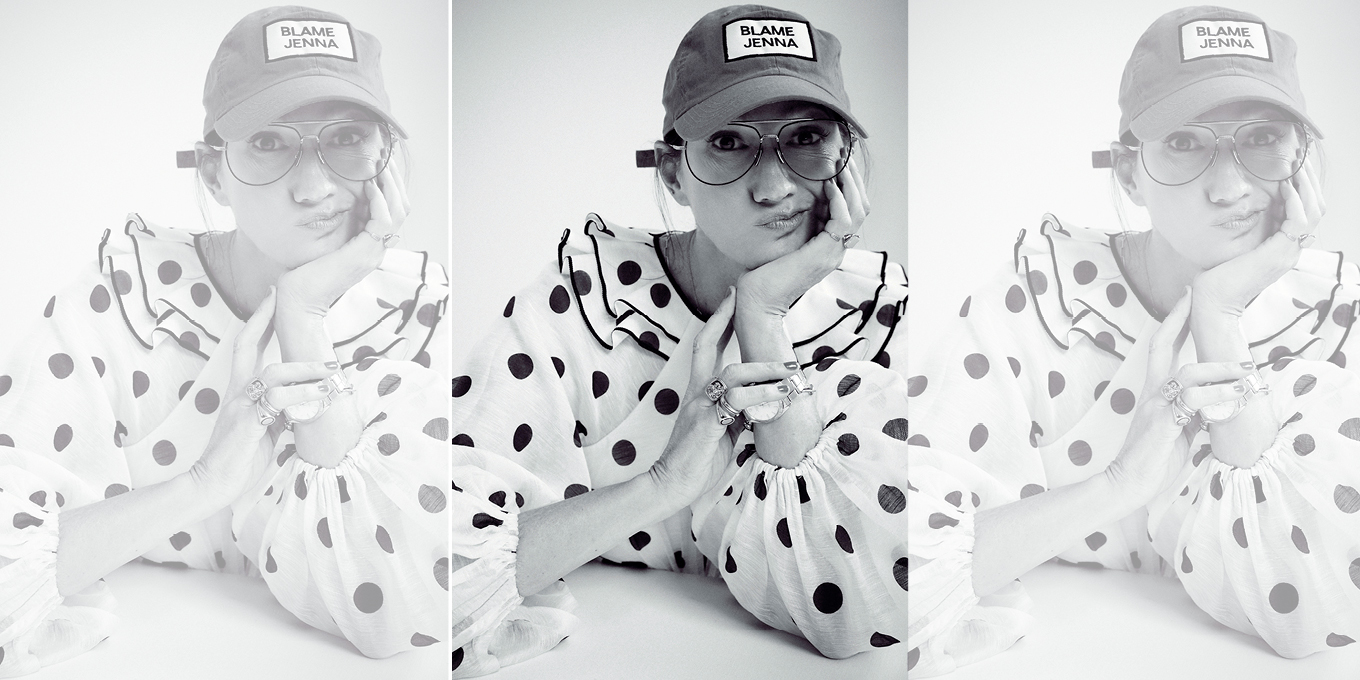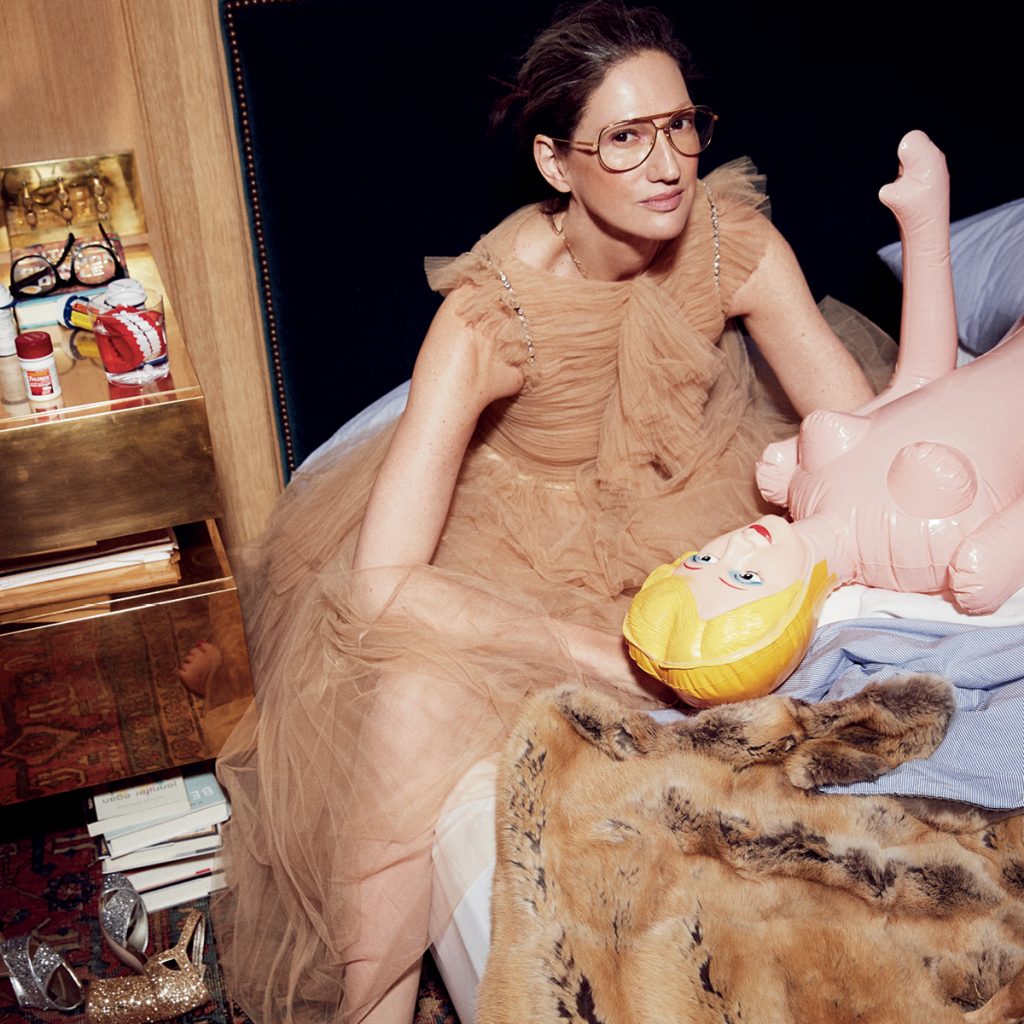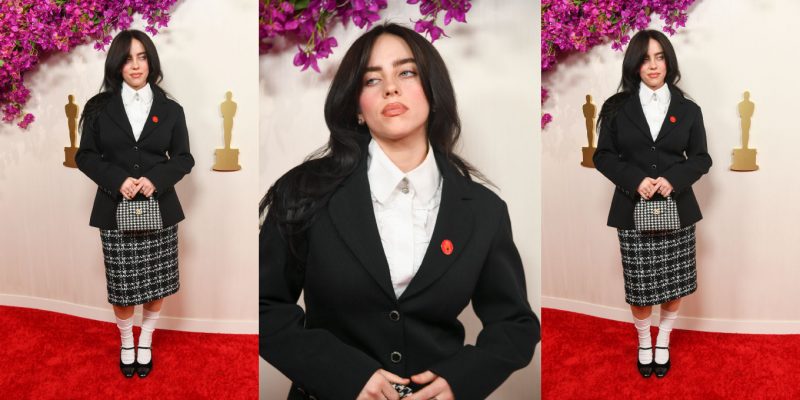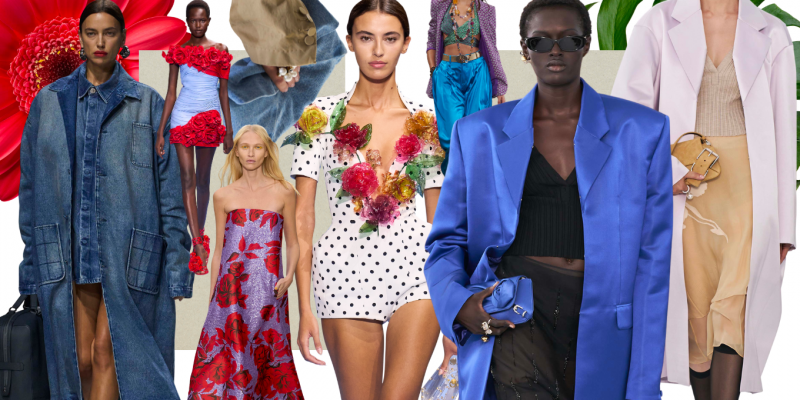Fashion
Super Jenna
She helped turn J.Crew into a multi-billion-dollar business and became a celebrity and pin-up for high-low dressing in the process. But when Jenna Lyons lost it all, she had to find a new—and surprising—way forward.
by : Ellie Austin- Apr 16th, 2021

Photographer COLIENA RENTMEESTER Stylist SARAH CLARY
Jenna Lyons’ front door is so unassuming that I walk past it three times before realizing it’s the entrance to an apartment and not the back door of one of the chi-chi designer stores in Manhattan’s SoHo district. I ring the buzzer and wait in a tiny, characterless hall for the elevator. If it weren’t for a sticker on the wall-mounted mailbox bearing the word “Lyons,” I might think that I’d stumbled into an office lobby rather than the residence of someone whose inimitable, offbeat style choices redefined the way a generation of women thought about fashion.
The elevator delivers me into an enormous and, yes, exquisitely decorated loft. To the left is the living area, framed by five two-and-a-half-metre-high windows and packed with an eclectic mix of art and furniture: a huge L-shaped coral sofa, a folding screen made from Hermès jungle-print fabric, Fred Sandback prints on the mantel and various scattered armchairs. And then there’s the kitchen, with its sweeping marble counter glistening beneath a glass Venini chandelier.
In front of me stands Lyons herself, all six feet two inches of her, as elegantly made up as her home. She wears a black Joseph Altuzarra dress, towering Aquazzura heels and a white silk scarf that pinches around her collarbones. On most women, it would look classic—a little boring, perhaps—but Lyons wears it with a sucker punch of oversized gold glasses and choppy shoulder-length hair. Were you not to know who Lyons is (most people in New York do), you might think she’s a Supreme Court judge who got ambushed by a 1980s optician on her way to work.
“I know—it’s Ruth Bader Ginsburg does Dallas,” she says, laughing. She speaks softly and fast, switching to a high-pitched, cartoonish voice when she wants to bat away a compliment or dodge a tricky question. “I had a photo shoot earlier, which is why I’m dressed like this,” she says. “Otherwise, you would have found me in my pyjamas.”
It’s this ability to inhabit the aspirational world of high-end fashion one minute and be distinctly relatable the next that explains why Lyons is—for many women—the epitome of style. Ever since she first hit the public consciousness as executive director of J.Crew, Lyons—with her signature slicked-back hair, chunky glasses and unexpected sartorial combinations (ripped jeans with sequins or a leopard-print coat over polka-dot trousers)—has been an unofficial ambassador for those who want to make a statement with their outfits, whatever their budget.
Yet she struggles to define her own style. “I find it hard to use fashion descriptors,” she says in her slight Californian drawl, ushering me toward the sofa. “One day I’m going for a grandma look, the next it’s a sexy secretary, the next it’s a more masculine, mailman look.”
Lyons began her career at J.Crew, starting out as an assistant menswear designer in 1990. It was only when she became creative director at 36, however, that the company went from being a business that sold good-quality preppy basics to one the world wanted a piece of. She was as much the brand’s face as the brains behind it, and her penchant for mixing expensive-looking items (jewelled necklaces, rainbow-coloured skirts and glittery heels) with simple everyday pieces (buttoned denim shirts and classic knitwear) infiltrated collections, turning high-low dressing into a popular style choice in its own right. Before long, J.Crew became a staple of royal wardrobes, with Kate Middleton, and then Meghan Markle, relying on the brand’s blazers, cropped trousers and cashmere sweaters to signal a sense of relatability while carrying out their public duties.
 Photographer COLIENA RENTMEESTER Stylist SARAH CLARY
Photographer COLIENA RENTMEESTER Stylist SARAH CLARYFashion’s transformational power dawned on Lyons early on. Born in Boston and raised in California by her piano-teacher single mother, Lyons was picked on for looking different. She was not only taller than her peers but also suffered from a rare disorder called incontinentia pigmenti, which caused her hair and eyelashes to fall out and her skin to scar. After receiving a fashion-magazine subscription from her grandmother, she would pore over images of models in Issy Miyake dresses and outlandish makeup. “I saw that beautiful clothes can change who you are and how you feel,” she says.
She won a place at New York’s prestigious Parsons School of Design and joined J.Crew weeks after graduating. Over the next two decades, she rose through the ranks, ultimately getting promoted to president in 2010 by CEO Mickey Drexler. A visionary duo sometimes described as retail’s answer to Apple’s Steve Jobs and Jonathan Ive, they transformed J.Crew from a staid catalogue-only business known for rugby shirts and dull-looking cardigans into a multi-billion-dollar high-street juggernaut that showed collections at New York Fashion Week and had Michelle Obama singing its praises during late-night-TV interviews.
“To have Michelle Obama on The Tonight Show With Jay Leno saying that she was wearing our clothes and that she’d bought them online—that created a sense of connectivity at a time when we didn’t have access to celebrities via Instagram,” says Lyons. “She was basically saying ‘I’m like you; I shop where you shop.’ In an era when celebrities only wore high-end designers, we were reaching across an unusual line.”
For a time, Lyons was a darling of the fashion world, branded “the woman who dresses America” by The New York Times. Her personal life also seemed picture-perfect, with a husband (artist turned restaurateur Vincent Mazeau), a young son and a Brooklyn brownstone so stylish that it became one of the most- pinned interiors on Pinterest after appearing in a magazine. To the outside world, she had it all.
“I will never forget getting into a cab in Paris one day and the driver saying: ‘You’re Miss Lyons! I saw you on the cover of Madame Figaro.’ I was like, ‘Holy shit!’ You have that moment and it’s incredible, and then you’re back in the office negotiating with merchants—some of whom are half your age. It’s humbling. They [didn’t] have to listen to me just because I [was] getting my name out there—actually, [the press I did at the time] made my job harder.”
“In what way?” I ask.
“I got too much credit,” she says matter-of-factly. “Imagine working for me at that time. In interviews, I’d talk about how I worshipped the ground my team walked on, but that’s not what people wanted to hear, so it never got printed. I’m sure the team thought ‘She’s making it all about herself.’” She raises her eyebrows knowingly. “Try going into work with all of that.”
In 2017, it was announced that Lyons was leaving J.Crew as part of a “mutual decision.” It was a wise time to jump ship. By 2014, there were already murmurs of discontent from customers, who complained about inconsistent sizing, poor-quality garments and unreasonable pricing. Two years later, the company had a debt load of more than $2 billion, and it filed for bankruptcy in May 2020.
“In fashion, there is no possible way for you to stay the love child,” says Lyons about the tumultuous period. “Having gone through really tough times, like 9/11 and the [2008] downturn, you start to see that there is a natural cadence to business. But, yes, it does hurt. I’m human, and I fixate on every fault I make.” She points to where I’m sitting on the sofa. “I sat there for a really long time. It was dark.”
“I had a girlfriend, a massive job and three assistants.”
There is a vulnerability to Lyons that appears at odds with her “force to be reckoned with” public persona. She frequently references making mistakes or feeling ill-equipped to handle projects, and you feel that this comes from a genuine sense of self-doubt rather than a faux display of modesty. I wonder whether, no matter how sparkling her professional achievements, part of her will always be that gangly teenager who was made to feel like an outsider.
Yet it’s clear that she is also quietly and unwaveringly resilient. In 2011, she divorced her husband and started dating—to the surprise of many—Courtney Crangi, co-founder of the New York-based jewellery company Giles & Brother. Lyons kept the relationship secret from everyone, including her family, until she was unceremoniously outed by an article in the New York Post. For a while, the internet was scandalized by the idea of a high-profile figure who busts every tired stereotype of how a gay woman should look and act.
As the headlines rolled, Lyons grappled with how to protect those closest to her. “I remember my mom saying, ‘What am I supposed to tell people?’” she says. “I replied: ‘You don’t have to make them comfortable. You don’t have to say anything, or you could say that it’s weird for you too.’ I wanted her to know that she didn’t have to take care of other people’s feelings.” A few months after Lyons left J.Crew, she and Crangi broke up. “I had a girlfriend, a massive job and three assistants, and they all went away,” she says, laughing. “I didn’t control my finances or pay my bills.” She looks sheepishly at the ceiling. “There may have been some collection notices.”
Lyons initially imagined that her next role might be at a big fashion house, but the phone didn’t ring. “I thought I’d get calls, but there was nothing,” she says. She has theories as to why this was: It’s hard to hire someone who is the face of another company, plus she was back on the job market at a time when fashion brands were breaking up big leadership jobs into several smaller roles.
Whatever the reason, she knew that she needed to think laterally about her future. After spending a few months holed up in her apartment (“I did not socialize; I did not go out”), she started making calls and arranging meetings. One of the first people she met with was U.S. Vogue editor-in-chief Anna Wintour. Job offers weren’t pouring in as Lyons had hoped, but fashion’s biggest players still wanted to hear from her.
“I said, ‘I don’t know what to do,’ and Anna said, ‘You should do TV.’” Lyons wasn’t convinced, but when a top TV executive suggested she shoot a pilot about the reality of launching a business, she agreed. Part reality show, part luxuriously shot documentary, Stylish With Jenna Lyons is an eight-part series on HBO Max in which a gaggle of flamboyantly dressed young creatives fight to be hired for Lyons’ new endeavour.
 Photographer COLIENA RENTMEESTER Stylist SARAH CLARY
Photographer COLIENA RENTMEESTER Stylist SARAH CLARYThe new company, Sort of Creative—which will take on beauty, fashion and interiors projects—is run out of a studio beneath Lyons’ apartment by a team that includes a couple of former J.Crew employees. Lyons is the first to admit that the process, from figuring out the purpose of the business to launching products during a pandemic (LoveSeen, a line of luxury lashes, went on sale in September), felt vaguely chaotic. “I was completely blind and made mistakes at every step,” she says. “For 27 years, I knew what my job entailed and where my paycheque was coming from. This was the complete opposite, and it was as scary as it was exciting. It was the people I work with who got me through.”
You sense that although Lyons is the boss, she relies on her staff for company and emotional support as much as they look to her for professional direction. “It’s one thing to go home and cry to your spouse, but I don’t have that,” she says with a hint of sadness. “Having this crew around me is gold.”
There are voices behind us, and Beckett, Lyons’ 14-year-old son, pads into the kitchen with a friend. “Hi, sweetie,” Lyons coos lovingly. “Do you two need anything?”
When New York went into lockdown last March, Beckett left the city with his father. “My ex-husband has a lake house, and I have a country house [in upstate New York] that I share with my ex-girlfriend,” says Lyons. “Her New York apartment is very small, and I didn’t want to ask her to leave the upstate house, so I stayed here while everyone else was gone. I was alone for two months straight. It was…intense.”
She survived on ravioli (“I don’t cook, and every restaurant was closed”) and relied on Zoom workouts with friends for interaction. Did she consider dipping her toe into online dating?
“We can’t even talk about that! I’m gay!” she exclaims, adding that New York’s lesbian dating scene isn’t as vibrant as you might imagine. “I just read that there are only 15 female gay bars left in the whole of the U.S. Isn’t that crazy?” She worries that attitudes toward the gay community have only regressed since she was involuntarily outed in 2011. “[Under the Trump administration], we [saw] more prejudice than ever, and we’ve sworn someone into the Supreme Court [Amy Coney Barrett] who could help overturn same-sex marriage,” she says. “I hope that things shift [now]. Where we were [was] very scary.”
“I don’t have to check in with anyone. I make the decision that feels right to me.”
We wrap up, and Lyons suggests that we walk through her studio on the way out. It’s bright and airy with long communal tables and black-and-white prints on the walls. Her team—all young, peppy and casually dressed—tap away on laptops as their boss glides around enveloping them in hugs and looking like she has just stepped off a runway.
Lyons may feel out of her depth without the scaffolding of her old life at J.Crew, but she has never lacked people who believe in her ability to make a roaring success of whatever she turns her hand to. “If you’d asked me three years ago what I’d be doing now, I don’t think I would’ve said this,” she says with a smile, gazing around the studio. “But I don’t have to check in with anyone; I make the decision that feels right to me. That feels like a whole new form of achievement.”
Read more:
12 On-Point Swimsuits You Should Scoop Now
FYI, the Mini Ugg Is Having a Major Moment Right Now
We’re Loving Canadian Designer Aurora James’ Ethically-Made Accessories
Newsletter
Join our mailing list for the latest and biggest in fashion trends, beauty, culture and celebrity.
Read Next
Fashion
The Most Iconic Looks In Met Gala History, From 1973 To Now
40 years of the night that's all about trailblazing fashion.
by : ELLE Australia- Apr 24th, 2024

Beauty
Dr. Idriss Skincare Is Finally Available in Canada
We chatted with the internet's favourite derm about her routine, overrated (and underrated!) skincare advice and why butt paste is her secret cure for inflamed skin.
by : Melissa Fejtek- Apr 24th, 2024

Culture
ELLE Escapes: Savannah
Where to go, stay, eat and drink in “the Hostess City of the South.”
by : ELLE- Apr 15th, 2024






